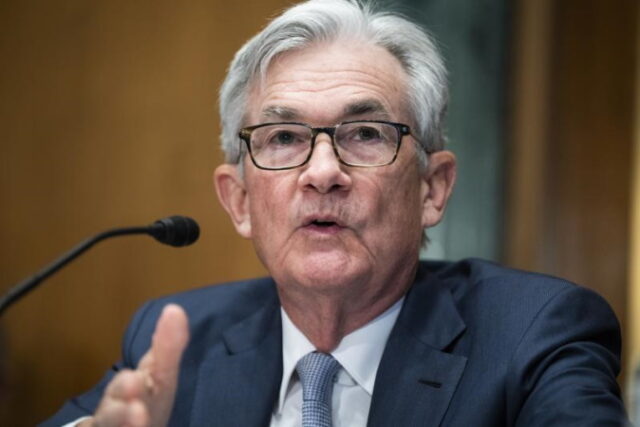
Written by James Royal – 5 min read – Edited By Brian Beers
The Federal Reserve announced that it’s raising interest rates 0.25 percent higher, following its March 15-16 meeting, bumping the federal funds rate to a target range of 0.25 to 0.50 percent. The move follows a period of months during which the nation’s central bank has reduced liquidity in the financial system and repeated that it would hike rates in the near term.
The Fed’s move comes as inflation rages in the U.S. economy at the highest annual rate in some 40 years, hitting 7.9 percent in February. With the Fed starting to tap the brakes on an overheated economy, the main question for many market watchers is just how fast Federal Reserve Chairman Jerome Powell will raise rates. Many experts are worried that the Fed will raise rates too quickly, potentially creating further instability and the potential for a recession.
“By raising interest rates, the Federal Reserve has begun the process of unwinding their pandemic-era stimulus measures in an effort to tame inflation,” says Greg McBride, CFA, Bankrate chief financial analyst. “This isn’t a one-and-done but the start of a series of rate hikes for the remainder of this year and well into next.”
At about 2.19 percent, the 10-year Treasury bond is now at its highest level in nearly three years, as markets price in the expectation of sustained inflation and rising rates. After some ups and downs in 2021, the benchmark bond has soared since December 2021.
As the Fed embarks on what appears to be a longer period of raising rates, here are the winners and losers from its latest decision.
1. Mortgages
While the federal funds rate doesn’t really impact mortgage rates, which depend largely on the 10-year Treasury yield, they’re often moving the same way for similar reasons. With the 10-year Treasury yield zooming higher in recent months, as the market prices in expectations of the Fed raising rates, mortgage rates have risen alongside them.
“Mortgage rates have kissed the record-lows goodbye and have jumped a full percentage point in the past four months in response to inflation and the perceived steps the Fed will need to take as a result,” says McBride.
Despite the move higher, the current environment is still attractive if you’re looking to get a mortgage or you’re able to refinance an existing mortgage. But now may be the time to act before rates move even higher over the coming months and years.
Those who are unable to take advantage of low rates — perhaps because they’re underwater on their house — miss out here.
Here’s how to find the lowest mortgage rates today.
2. Home equity
The cost of a home equity line of credit (HELOC) will be ratcheting higher, since HELOCs adjust relatively quickly to changes in the federal funds rate. HELOCs are typically linked to the prime rate, the interest rate that banks charge their best customers.
Those with outstanding balances on their HELOC will see rates tick up, though interest expenses may continue to be low historically. A low rate is also beneficial for those looking to take out a HELOC, and it can be a good time to comparison-shop for the best rate.
But with rates moving higher, even a little bit, and the expectation that they’ll move higher still as the year progresses, those with outstanding HELOC balances should expect to see their payments continue to rise in the near term. (Here are the pros and cons of a HELOC.)
3. Credit cards
Many variable-rate credit cards change the rate they charge customers based on the prime rate, which is closely related to the federal funds rate. The Fed’s decision means that interest on variable-rate cards is likely to move higher now.
“Rates for credit cards will reprice quickly – often within one or two statement cycles – any time the Fed raises interest rates,” says McBride. He says rates could go up at a faster pace than we’ve seen in many years.
“Pay down and pay off variable rate debt such as credit cards as the cost of that debt is only going to grow over the next couple of years,” he says.
If you have an outstanding balance on your cards, then you’re going to get hit with higher costs. With rates projected to rise for a while, it could also be a welcome opportunity to shop for a new credit card with a more competitive rate.
Low rates on credit cards are largely a non-issue if you’re not running a balance.
4. Savings accounts and CDs
Rising interest rates mean that banks will offer rising returns on their savings and money market accounts but will likely adjust their yields at a measured pace.
CD owners who locked in rates recently will retain those rates for the term of the CD, unless they’re willing to pay a penalty to break it.
Those with savings accounts may look forward to rising rates, but it’s off a low base, as most banks quickly ratcheted rates to near zero following the Fed’s emergency cuts in March 2020.
“The outlook for savers is a lot better going forward than what they’ve endured over the last two and a half years, but it will be a long road back,” says McBride. “The Fed will raise interest rates in an effort to corral inflation, but it will take many interest rate hikes to bring inflation back down to 2 percent and raise savings rates above 2 percent.”
Savers looking to maximize their earnings from interest should turn to online banks, where rates are typically much better than those offered by traditional banks.
5. Stock investors
A huge boon for the stock market has been the Fed’s willingness to keep rates at near zero for an extended period of time. Low rates have been beneficial for stocks, making them look like a more attractive investment in comparison to rates on bonds and fixed income investments such as CDs. But that’s changing.
In the last few months, investors have been pricing in the potential for rate increases, and the S&P 500 started 2022 in a deep slump.
“The stock market has been volatile since the beginning of the year as the Fed is poised to rein in the stimulus of low rates and bond purchases that have buoyed stock prices,” says McBride.
Cryptocurrencies have also been feeling the brunt since November, when the Fed more clearly telegraphed its intentions to reduce liquidity in the financial system. Bitcoin, Ethereum and other major cryptos are well off their 52-week highs and have shown a solid downtrend over the last few months, as they priced in reduced stimulus and the potential for higher interest rates.
“While volatility will ensue and the returns won’t come as easy in 2022 as they did in 2021 and much of 2020, the economy and corporate earnings are both continuing to grow, which will ultimately reward patient and disciplined investors,” says McBride. “Maintaining the long-term perspective is vitally important amid short-term volatility.”
6. The U.S. federal government
With the national debt above $30 trillion, rising rates will raise the costs of the federal government as it rolls over debt and borrows new money. Of course, the government has benefited for decades from a secular decline in interest rates. While rates might rise cyclically during an economic boom, they’ve been moving steadily lower long term.
For now, the interest rates on debt remain at historically attractive levels, with 10-year and 30-year Treasurys running well below inflation. As long as inflation remains higher than interest rates, the government is slowly taking advantage of inflation, paying down prior debts with today’s less valuable dollars. That’s an attractive prospect for the government, of course, but not for those who buy its debt.
Bottom line
Inflation has been running hot over much of the last year, and the Fed has finally announced that it’s raising rates to combat it. But rates still do remain low by historical standards, at least for now, so it makes sense to think about how to take advantage, whether that means getting a mortgage before rates rise further or being more discriminating when it comes to shopping for rates on your savings accounts or CDs.
Learn more:
Republished with permission[/vc_message]












